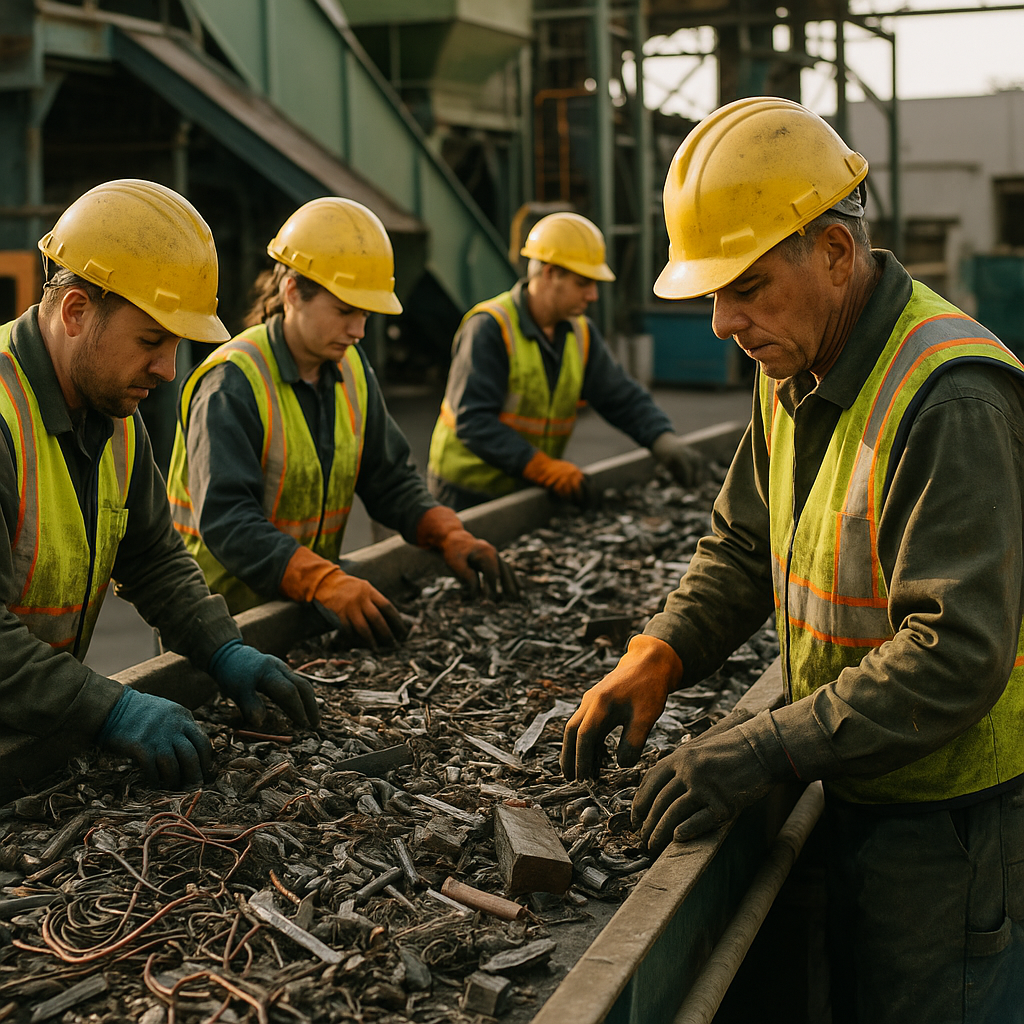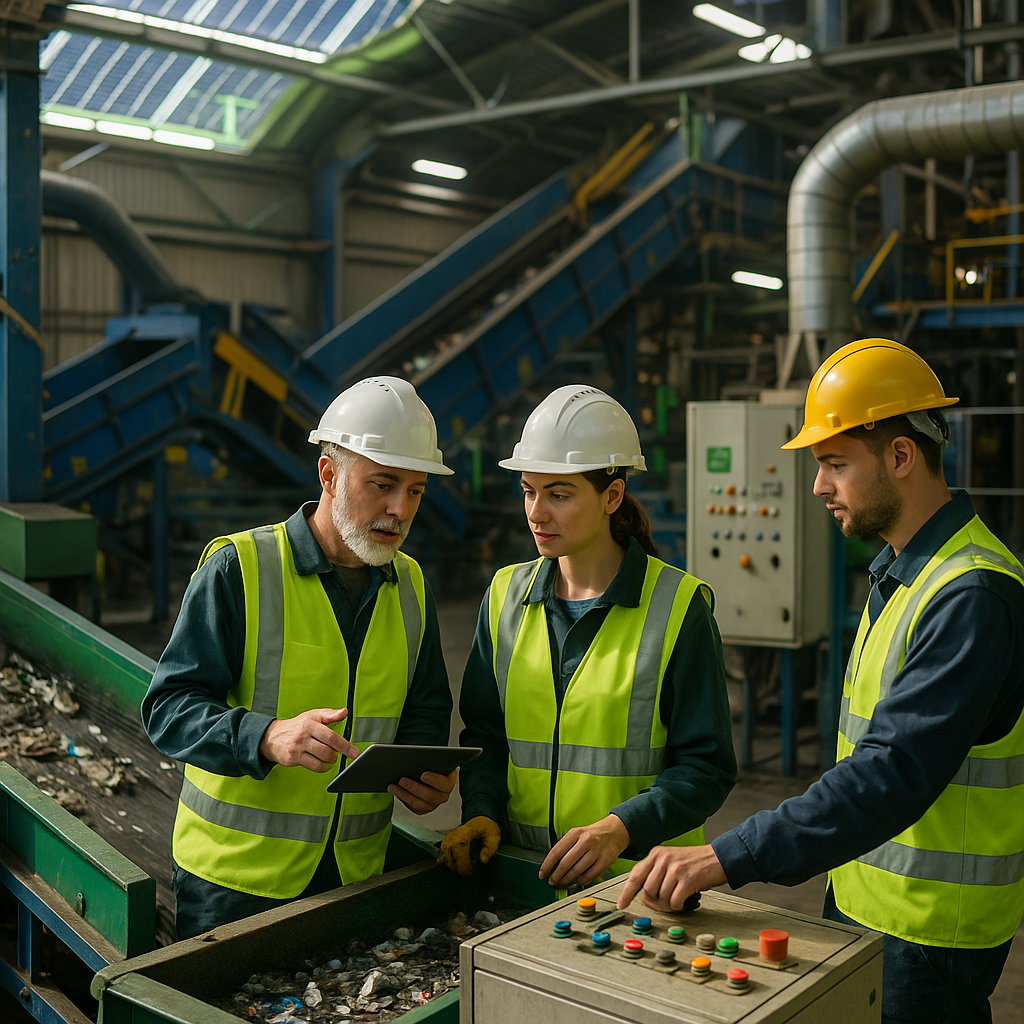5901 Botham Jean Blvd, Dallas, TX 75215
Metal Recycling Supply Chain: Challenges, Innovations, and Sustainability Benefits
October 11, 2025Recycling one ton of steel conserves approximately 2,500 pounds of iron ore, 1,400 pounds of coal, and 120 pounds of limestone. The metal recycling supply chain transforms potential waste into valuable resources through a series of interconnected stages. This process begins with collection and ends with the creation of new products from previously used materials.
The metal recycling supply chain consists of a sequence of operations that convert discarded metal items into raw materials for manufacturing. Collection centers gather scrap from various sources, including residential, commercial, and industrial sectors. This material then undergoes sorting to separate metals by type, with ferrous and non-ferrous materials requiring different handling methods.
Once sorted, the scrap metal enters processing facilities where it’s shredded, crushed, or baled to prepare for melting. The melting stage transforms the prepared scrap in specialized furnaces, followed by purification to remove contaminants. The final stages involve solidifying the metal into forms suitable for manufacturing and distributing these recycled materials to industries that create new products.
What Are the Key Challenges in Metal Recycling Supply Chains?

Contamination poses one of the most significant hurdles in metal recycling supply chains. Non-metallic materials, chemicals, paint, oil, and dirt often enter recycling streams, reducing the quality and value of recovered metals. If contaminants persist in the recycling process, they can compromise the final product’s integrity, necessitating additional processing and increasing costs.
Price volatility creates substantial uncertainty throughout the metal recycling industry. In current markets, scrap metal prices can fluctuate by up to 30% within a month. These swings are driven by global economic conditions, currency exchange rates, and international trade policy changes. For instance, when China implemented its National Sword policy restricting scrap imports in 2018, markets worldwide scrambled to find new buyers, causing prices to plummet.
Complex product designs present growing challenges for recyclers. Modern electronics and vehicles contain multiple metals that are increasingly difficult to separate and efficiently recover. These products often feature tightly integrated components with metals bonded together or embedded within composite materials. The trend towards miniaturization in electronics further complicates recycling, as valuable metals appear in smaller quantities across more components.
- Contamination challenges: Recyclable metals frequently contain plastics, rubber, or hazardous substances that require separation before processing, slowing operations and reducing efficiency.
- Price fluctuation impacts: Economic downturns can lead to sharp price drops, while sudden demand increases can cause rapid spikes, complicating recycling operations planning.
- Design complexity issues: Products like smartphones contain over 30 different materials, making separation technically challenging and sometimes economically unfeasible.
- Regulatory compliance costs: Environmental regulations necessitate investments in pollution control equipment, water management systems, and administrative processes.
Environmental regulations present both challenges and opportunities for recyclers. Compliance with evolving standards requires significant investments in equipment, monitoring systems, and administrative processes. The Clean Water Act mandates that scrap yards implement stormwater management plans and secure water discharge permits. These systems are costly to install and maintain, creating downward pressure on the prices recyclers can offer suppliers.
Infrastructure limitations also pose significant obstacles in many regions. Insufficient or outdated recycling facilities hinder efficient collection, sorting, and processing of recyclable materials. These limitations create bottlenecks, increase transportation costs, and cause processing delays, reducing the effectiveness of recycling efforts.
Transportation and logistics hurdles further complicate the recycling process. Space constraints necessitate careful planning to manage routes and allocate sufficient storage space. Handling large volumes of scrap metal also presents safety risks, requiring comprehensive training programs and robust safety protocols to prevent injuries.
How is Digitalization Transforming Metal Recycling?

The metal recycling industry is experiencing a significant transformation due to digital technologies. AI-powered sorting systems can now identify and separate different metal types with remarkable accuracy and speed. These systems use high-resolution cameras and deep learning algorithms to analyze the unique visual patterns of metals, often referred to as the material’s “optical fingerprint.”
Companies like METYCLE and Binder+Co are at the forefront of this transformation with AI solutions that can distinguish among various aluminum alloys by noting subtle differences in texture, surface properties, and manufacturing marks. A single AI-powered sorting system can handle 5-15 tons of material per hour, significantly outpacing traditional methods.
Blockchain technology is introducing essential transparency to the metal recycling supply chain. Every transaction, from collection to processing, can be recorded in a tamper-proof digital ledger. This ensures accountability at every step and allows tracking of materials from source to smelter. For instance, the Dutch Ministry for Infrastructure has implemented blockchain solutions to monitor waste transit, enhancing verification of recycling claims.
Advanced data analytics is another major advancement for the industry. Recyclers can use digital platforms to analyze market trends, predict material flows, and optimize operations. These insights help facilities maintain better inventory management and enable more accurate pricing based on real-time market conditions rather than outdated estimates.
Importantly, digital solutions are dismantling information silos between supply chain partners. When one recycling facility has an excess of certain materials, they can quickly connect with other processors through digital networks, rather than sending valuable metals to landfills. This coordinated approach improves efficiency across the entire recycling ecosystem.
Smart sorting hubs equipped with sensors can evaluate incoming materials for composition and quality, creating digital product passports that track materials throughout the recycling journey. This technology allows for monitoring of CO2 savings from source to smelter and reduces uncertainty about product quality, leading to more accurate pricing and fewer costly claims between supply chain partners.
The economic benefits of digitalization are significant. AI-based sorting systems generally have lower capital costs than specialized equipment like Laser-Induced Breakdown Spectroscopy (LIBS), are simpler to operate, and are not subject to radiation-related regulations affecting X-ray-based systems. When specialized analysis is necessary, AI can manage the bulk separation, enabling more expensive systems to process only a portion of the material.
What Economic and Environmental Benefits Does Metal Recycling Offer?

Metal recycling serves as a significant economic engine in the United States, contributing over $105 billion annually to the national economy and creating sustainable employment opportunities. Recycling facilities generate up to 10 times more jobs than traditional landfill operations, translating to more than 681,000 jobs across collection, processing, and manufacturing sectors.
The Institute of Scrap Recycling Industries indicates the industry provides approximately 506,000 American jobs and contributes about $5 billion annually in revenue to local governments. The ferrous metals sector delivers the largest economic impact, followed by construction and demolition materials and non-ferrous metals like aluminum.
For manufacturers, recycled metal offers substantial cost advantages. Companies can achieve up to 33% in production cost savings compared to using virgin materials, aligning economic benefits with environmental goals.
Direct Financial Benefits for Businesses
Businesses implementing metal recycling programs gain immediate financial benefits, primarily from selling metal scrap that would otherwise be discarded. Unlike paper fibers that degrade with each recycling cycle, metal can be melted down and reformed repeatedly without quality loss.
Companies also benefit from reduced waste disposal costs. By diverting metal from general waste streams, businesses lower their trash collection fees and landfill expenses. Manufacturing facilities producing substantial metal waste can achieve significant savings through these reductions.
Additionally, metal recycling helps stabilize supply chains by providing reliable material sources. This reduces dependence on volatile raw material markets and creates more predictable cost structures for long-term planning.
Environmental Advantages
The environmental benefits of metal recycling are equally compelling. Energy savings stand out as a primary advantage. Recycling aluminum saves up to 95% of the energy required for virgin production, while steel recycling reduces energy consumption by 60-70% compared to producing new steel from iron ore.
These energy reductions directly translate to lower carbon emissions. Steel recycling cuts CO2 emissions by up to 58% compared to primary production methods. Each ton of aluminum recycled prevents approximately 9 tons of CO2 emissions from entering the atmosphere.
Resource conservation is another crucial benefit. According to the EPA, recycling one ton of steel conserves 2,500 pounds of iron ore, 1,400 pounds of coal, and 120 pounds of limestone. This preservation of natural resources helps protect ecosystems and reduces environmental damage from mining operations.
Metal recycling also prevents harmful materials from entering landfills. Metals can take centuries to decompose and potentially leach toxic substances into soil and groundwater. By keeping these materials in circulation, recycling helps protect water sources and surrounding communities.
Supporting Sustainability Goals
Beyond immediate economic and environmental benefits, metal recycling helps organizations meet important sustainability standards. Companies implementing robust recycling programs often enjoy enhanced brand reputation as consumers increasingly favor environmentally responsible businesses.
The circular economy model gains significant support from metal recycling practices. Unlike many materials, metals maintain their properties regardless of how many times they are recycled. This perfect circularity makes metals ideal for sustainable material cycles and supports long-term resource management strategies.
With global demand for metals rising due to green technologies like electric vehicles and renewable energy infrastructure, recycling helps meet this demand sustainably. Recycling serves as a crucial bridge between economic growth and environmental protection, offering rare win-win solutions to our resource challenges.
Conclusion: The Future of Metal Recycling Supply Chains

The metal recycling industry is at a pivotal moment, with global market projections indicating growth from $552 billion in 2024 to over $1 trillion by 2034. This expansion highlights the increasing role of recycled metals in building sustainable supply chains across manufacturing sectors. Technological innovation drives this transformation, with AI-powered sorting systems, blockchain for supply chain transparency, and advanced processing methods enhancing recycling efficiency.
Environmental and economic benefits continue to reinforce each other within the metal recycling ecosystem. Recycled aluminum saves 95% of the energy needed for primary production, while steel recycling conserves 75%. These efficiency gains lead to substantial reductions in greenhouse gas emissions and create economic opportunities. The shift toward a circular economy model for metals seems irreversible as regulations tighten and consumers demand more sustainable products. For your recycling needs and to join the movement toward a more sustainable future, contact Okon Recycling at 214-717-4083.
